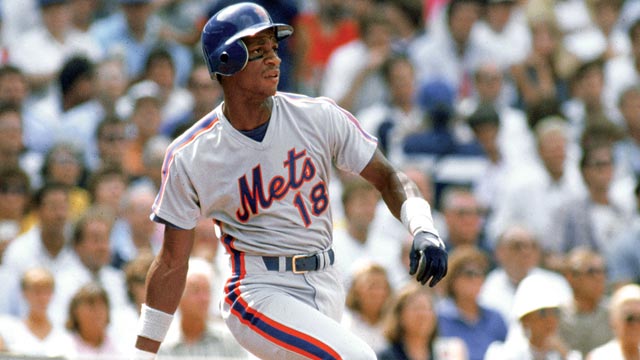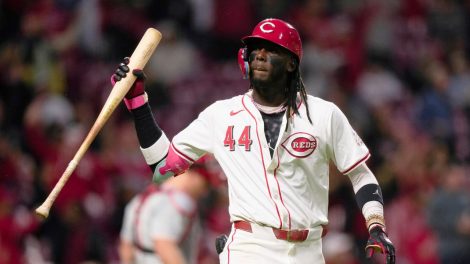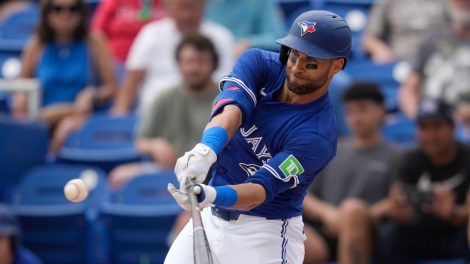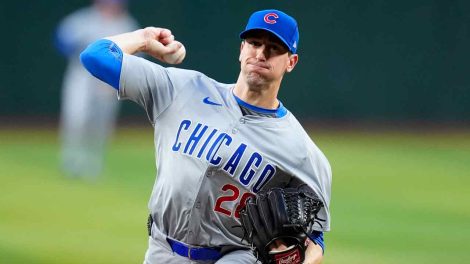It was The Simpsons’ third season and the only star they’d ever landed was Tony Bennett. That changed on Feb. 20, 1992, when “Homer at the Bat” was beamed into millions of homes across North America, featuring guest appearances by Wade Boggs, José Canseco, Roger Clemens, Ken Griffey Jr., Don Mattingly, Steve Sax, Mike Scioscia, Ozzie Smith and Darryl Strawberry. On the occasion of The Simpsons marathon on FXX, here’s how it all came together (complete with a player’s allegedly disgruntled ex-wife and the most controversial sideburns in baseball)—as told by members of the show’s cast and crew and two of the game’s biggest names.
JEFF MARTIN, WRITER: A lot of us would sneak a look at the box scores during rewrites. So baseball was very much in the air. Easy jump from there to Homer’s on the softball team.
AL JEAN, EXECUTIVE PRODUCER: I remember [fellow executive producer] Sam Simon said, ‘We can actually get nine great baseball players. We’ll just get these guys when they come out to play the Angels or the Dodgers. Shoot for a real all-star team.’ Mike Reiss and I were running the show at that time, and I thought Sam was crazy. But, of course, he was right. We had about an 80 percent success rate. I’d just never seen anything like it on TV.
DAN CASTELLANETA, HOMER SIMPSON: That show had, probably to this day, more stars in it than any of the other shows.
JEAN: The first one who said yes might have been Ozzie Smith. Usually when one of them signs on, others say, ‘Well, if he’s doing it, I’ll do it.’
MARTIN: Some of them came into our studio, but for others, we had to go rent a studio near whatever ballpark they were in town playing in. It took a fair amount of work to put it all together.
JEAN: John Swartzwelder wrote the script. I think in his script was the original joke about Burns having a guy who’d been dead 107 years. Swartzwelder looked something up—it wasn’t as easy without the Internet—some Cleveland Spiders outfielder who died 107 years ago. Swartzwelder, by the way, looks exactly like an old-time ballplayer. He’s got a moustache and he’s very tall. If you put a Reds uniform on him, he would look completely in place.
MARTIN: I’m a big Red Sox fan, so I was like, ‘Let me do Clemens and Boggs.’ I remember they were appearing as guests on Roy Firestone’s old talk show. So I went in before that. They were both beautifully dressed, which is an odd thing to remember. Clemens seemed enormously strong. I had to say, ‘Roger, I need you to cluck like a chicken.’ I was half expecting him to say, ‘What? No! Do you know who I am?’ but without skipping a beat he clucked like a chicken.
MIKE SCIOSCIA, FORMER L.A. DODGER CATCHER AND CURRENT MANAGER OF THE LOS ANGELES ANGELS OF ANAHEIM: When I saw the script and saw all the guys who committed to it, which was basically the whole all-star team, I was excited. I figured we’re all going to get together and do this, and they called me in to read my lines and I was in there with two other guys who weren’t even ballplayers. I didn’t think it was going to be “We are the World” or anything like that, but I thought there would be some interaction or something going on. I remember they said, ‘Whistle a tune,’ because I was supposed to whistle a nondescript tune as I’m working. So, I just started whistling “Take Me Out to the Ball Game” and they loved it. That’s what they used.
CASTELLANETA: It was interesting to see that players who come through in the clutch and are under a lot of pressure were a little nervous standing in front of a microphone.
MARTIN: Ken Griffey Jr. was a really young guy with absolutely no acting aspirations whatsoever. He didn’t really want to do it. No knock, he just didn’t ask for this. I think we have Ken Griffey Sr. to thank for getting him to do it.
JEAN: Griffey came with his dad. We had this line where he was supposed to say, ‘It’s like there’s a party in my mouth and everyone’s invited!’ And he did not read it quite right. He just didn’t quite know how to say it. It was funny because his dad knew exactly what we wanted and he kept saying, ‘Junior, just say it like this.’ He didn’t know how to do it, so, finally, I put Mike Reiss in the booth with him to kind of help him. I thought he was going to take a bat to Mike.
JIM REARDON, DIRECTOR: At the time, Senior was still playing with him on the Mariners. I think they were going to be on Arsenio Hall that night. So he had a big day. Senior was all into it. He wanted to meet Dan Castellaneta. He was like, ‘Where’s Homer Simpson? I want to meet Homer Simpson.’
CASTELLANETA: I did meet them both at the recording studio and I said, in Homer’s voice, ‘Cubs were winning seven to five. Bottom of the ninth. Bruce Sutter comes in and you hit a three-run homer you lousy guy! Cost me 50 bucks!’
REARDON: Then Senior wanted to see the model sheet. I brought the model sheet of what Junior was going to look like and he thought that was hilarious, because he had the Simpson overbite and everything: ‘I’m taking this back to the clubhouse.’ Our character design staff had to be able to take any famous figure and draw them with no chin and a big overbite. They got to be pretty good at it, although Jay Leno was always the ultimate challenge.
MARTIN: I don’t know that any of those guys had personality quirks to be ripped on. It was much more random than that. We managed to scrape up nine different dilemmas. Wade Boggs could’ve easily gotten gigantism and Ken Griffey Jr. could’ve gotten into an argument with Barney about England’s greatest prime minister.
REARDON: Ozzie Smith was known for being a really snappy dresser so we tried to put him in the loudest Hawaiian shirt we could possibly design. And black socks with shorts. You take a chance when you’re a guest star on The Simpsons.
AL JEAN: Some athletes are just kind of stiff. With Darryl Strawberry, it kind of worked in his favour. Sam had pitched those lines where Strawberry was always sucking up to Burns: ‘No hustle, Skip.’ It was funny the way he said it—just deadpan and affectionless.
JEAN: Mattingly and Sax were there at the same time. Mattingly was aggravated because he said, ‘Wait a minute. I’m doing dishes and Sax gets to play in a [jazz] combo?’
DON MATTINGLY, FORMER YANKEES FIRST BASEMAN, CURRENT MANAGER OF THE LOS ANGELES DODGERS: I’m like, ‘Why am I doing dishes?’
JEAN: I said, ‘I’m sorry. That’s just what the script says, I can’t change it.’ We could’ve changed it, but I acted like my hands were tied.
MARTIN: We’d originally asked Ryne Sandberg, but he didn’t want to do it. No offence to Steve Sax. He was a fine player, but Sandberg was clearly headed for the Hall of Fame. Anyway, Sandberg didn’t want to do it, so we asked Steve Sax and he said yes. I remember Mike Reiss, who’s not a baseball fan, saying after the recording: ‘That is the closest I’ve come to falling in love with a man.’
JEAN: I pitched the idea that Burns thinks [Mattingly’s] hair is too long because my grandfather used to really be aggravated by what was not really very long hair, but even if it was a little long he would tell the kids who worked for him at the hardware store to get it cut. With Burns, no matter how short it was, it was too long.
MARTIN: I definitely remember Harry Shearer [the voice of Mr. Burns, Smithers, Flanders and others] and Julie Kavner [voice of Marge and others] pulling me aside and saying, ‘Why is this funny?’ They didn’t get it at all. And I said, ‘Well, Mr. Burns clearly has some notion in his head of what a sideburn is, and it’s incorrect.’ And saying it like that, it didn’t sound funny. But I still contend it was funny.
[On Aug. 15, 1991, Mattingly was benched by Yankees manager ‘Stump’ Merrill for refusing to cut his hair in accordance with a policy George Steinbrenner had instituted in 1973.]
MATTINGLY: The wildest thing for me about the whole thing was the shaved sideburns. Everybody thought that was the year of the “haircut incident” involving me in New York. The weirdest thing was that we recorded before any of that happened. It was like those guys knew the future when they wrote that in.
It was that season, but I know it was definitely after we’d already taped it. The manager’s the one who asked me to do it, but he didn’t ask me until right before the game. He said if you don’t get it cut you don’t play. So I didn’t play. It was kind of a principle thing. If he’d told me two days earlier, I would’ve done it, you know?
MARTIN: [Mattingly] says something like, ‘I still like [Mr. Burns] better than Steinbrenner.’ Mattingly was on the Yankees at the time and I remember we were like, ‘Is he going to say that?’ He didn’t bat an eye. He was happy to say it.
MATTINGLY: Mr. Steinbrenner was a pretty big figure, but he was kind of like: good or bad publicity, it’s still publicity. He had a pretty good sense of humour about himself, you know. Nobody [with the Yankees] ever said a word.
[The combined career earnings of the Springfield Nine total an estimated $502,124,805]
JEAN: They all get residuals still.
MATTINGLY: I think the last one was for $1.28 or something. I had one that was 89 cents. I just wanted to screw with them, you know? You get an 89-cent cheque, I figured I’d sign it and auction it off for charity, somebody would like it because of The Simpsons. And then, whoever’s trying to keep track of the accounting is saying, ‘Where’s that cheque?!’
MARTIN: The only one with an attitude was Canseco.
JEAN: Canseco was married at the time and we had a scene where it was like Bull Durham where he was in a tub with Mrs. Krabappel. His wife was really mad. I don’t know whether there was a rumour about something going on in real life but she didn’t want him, even in the cartoon, to be in the tub with Mrs. Krabappel. So we had to rewrite it at the last minute.
REARDON: They came up with him saving a cat from a burning building or something like that. Something heroic. I don’t think the bathtub stuff ever got animated.
JEAN: Canseco did two takes—he wasn’t the greatest actor—and he goes, ‘OK, I’m finished.’ Wally [Wolodarsky, another of the show’s writers] goes, ‘Yeah, I think that’s good enough.’ And I’m going, ‘Wally, nobody does just two takes.’ I got, like, two more out of him, but it wasn’t easy. Canseco thought he’d done a good enough job.
MARTIN: The thing I really loved about the episode is that for the first third it was so set up as a feel-good underdog sports story. And then we just knock the legs out from under that. Like, when Mr. Burns says, ‘Do you really think this ragtag bunch of misfits can win the championship?’ And Smithers says, ‘I don’t know, sir.’ And he says, ‘Neither do I. That’s why I want you to hire ringers.’ It just goes from feel-good, team pulling together and all that, and then just totally, completely throws that out the window. The fact that they don’t hire one ringer—he hires nine major league baseball players. Just the heartless overkill of it; I thought it was really funny.
JEAN: For the credits, Terry Cashman parodied his “Talkin’ Baseball” song. He came in and sang it; Jeff Martin wrote the lyrics based on the episode. Jeff always said it was funny that you have this instant nostalgia for something you just saw. The original song is about old-time baseball; this one’s about something you saw one minute ago.
MATTINGLY: I’ve probably gotten more attention from that episode than anything. People, to this day, still yell, ‘Mattingly, shave those sideburns!’










